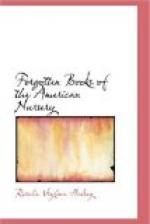Peter Parley took his heroes far afield. Jacob Abbott adopted another plan of instruction in the majority of his books. Beginning in eighteen hundred and thirty-four with the “Young Christian Series,” the Reverend Mr. Abbott soon had readers in England, Scotland, Germany, France, Holland, and India, where many of his volumes were translated and republished. In the “Rollo Books” and “Franconia” an attempt was made to answer many of the questions that children of each century pour out to astonish and confound their elders. The child reader saw nothing incongruous in the remarkable wisdom and maturity of Mary Bell and Beechnut, who could give advice and information with equal glibness. The advice, moreover, was often worth following, and the knowledge occasionally worth having; and the little one swallowed chunks of morals and morsels of learning without realizing that he was doing so. Most of both was speedily forgotten, but many adults in after years were unconsciously indebted to Goodrich and Abbott for some familiarity with foreign countries, some interest in natural science.
Notwithstanding the immense demand for American stories, there was fortunately still some doubt as to whether this remodelled form of instructive amusement and moral story-book literature did not lack certain wholesome features characteristic of the days when fairies and folklore, and Newbery’s gilt volumes, had plenty of room on the nursery table. “I cannot very well tell,” wrote the editor of the “Fairy Book"[216-A] in 1836,—“I cannot very well tell why it is that the good old histories and tales, which used to be given to young people for their amusement and instruction, as soon as they could read, have of late years gone quite out of fashion in this country. In former days there was a worthy English bookseller, one Mr. Newbery, who used to print thousands of nice little volumes of such stories, which, as he solemnly declared in print in the books themselves, he gave away to all little boys and girls, charging them only a sixpenny for the gold covers. These of course no one could be so unreasonable as to wish him to furnish at his own expense.... Yet in the last generation, American boys and girls (the fathers and mothers, grandfathers and grandmothers of the present generation) were not wholly dependent upon Mr. Newbery of St. Paul’s church-yard, though they knew him well and loved him much. The great Benjamin Franklin, when a printer in Philadelphia, did not disdain to print divers of Newbery’s books adorned with cuts in the likeness of his, though it must be confessed somewhat inferior.[216-B] Yet rude as they were, they were probably the first things in the way of pictures that West and Copley ever beheld, and so instilled into those future painters, the rudiments of that art by which they afterwards became so eminent themselves, and conferred such honour upon their native country. In somewhat later time there were the worthy Hugh Gaine, at the Sign of the Bible and Crown




